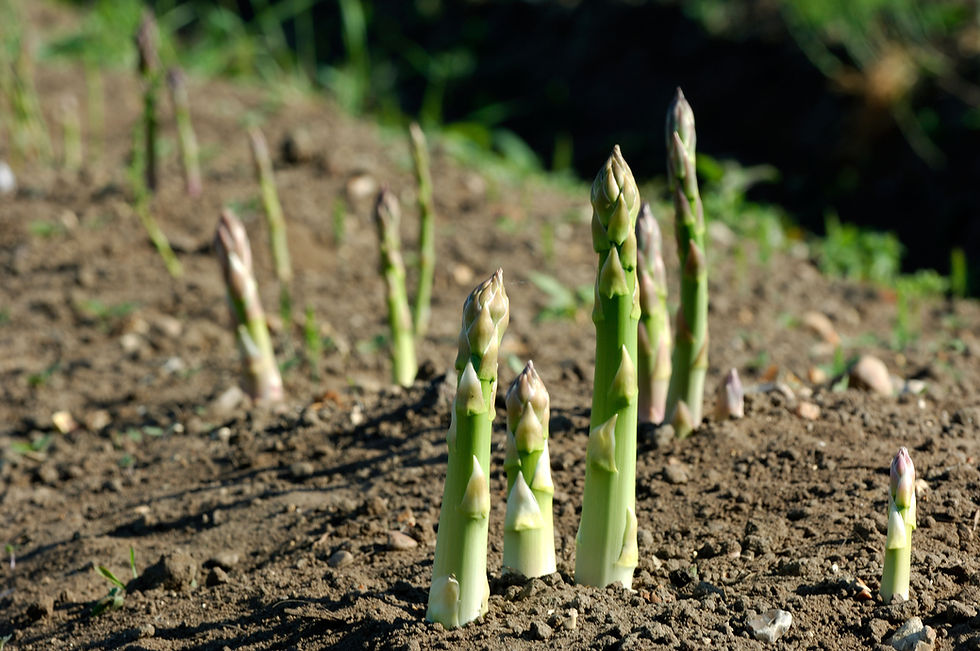Despairagus
- Barry Helm
- Apr 5, 2020
- 3 min read
Fresh asparagus spears, grilled and buttered. Delicious.
Asparagus does not grow in a day. Or in a season. It takes about three years before an asparagus plant can be fully harvested. Asparagus plants are most commonly established by planting clusters of roots and rhizomes called crowns. (Starting plants by seed is difficult and has a low success rate.) Once the crowns have been planted, it takes up to three growing seasons before the plant matures enough to withstand a full season of harvesting. Incredibly, healthy plants will produce harvests for years to come, fifteen to twenty years or longer.
Our family had three or four young asparagus plants growing in a small section of the garden. In the summer of 1999 I took it upon myself to care for these little guys and bring them to their full potential. In dry stretches of weather, I would take a large coffee can of water from the rain barrel, walk it out to the garden, and give each plant a drink. The asparagus appreciated it. I like to think we had a connection.
Then this happened. One afternoon I went out to water the plants, drawing water from the rain barrel at the house. As I made my way to the garden plot I saw it: my father had inadvertently tilled up the section with the asparagus in it. The plants were pulverized. I was devastated. I threw the watering can to the ground, fell to my knees, and wept in despair. Dramatic, I know. It seems like a gross overreaction, but my despair was not about the destruction of the asparagus plants. It was about much more. This was just the tipping point. Like a lightning rod, this incident captured the latent static of my discontent and I snapped.
The summer of 1999 was a difficult one for me. I had just returned from a year of studies at Providence Seminary (Otterburne, Manitoba), and I was still a year away from finishing my program. It was a program that interested me but had few job prospects, and the job prospects that were available paid much less than the median wage of someone with an equivalent level of education. This fact pricked me even more as I recognized that my younger brother, with a two-year program from a technical school, would easily land a job that paid twice as much as any career related to my area of study. And to underscore this feeling of failure, my younger brother was about to be married and I had no prospect of any nuptial arrangement. Furthermore, I was still living at home.
Twenty-seven years old, on a path with limited career opportunities and meager earning potential, relying on my parents for housing, single, and asparagus turned to tilth. Despairagus.
That summer marked a significant shift in the trajectory of my life. After that incident, I decided to place an ad in a local paper offering to clean windows. Shortly thereafter I began mowing lawns and landscaping yards. In the years that followed more equipment was purchased, staff were hired, and the company grew into what it is today.
But more than a career path, this trajectory afforded the opportunity for friendships I never would have had otherwise; it enabled me to have deeper, more meaningful relationships with many members of my family; and it positioned me to meet the woman who would become my wife.
There are two lessons that I draw from my experience. First, while it may appear to some that I drafted this grand schematic of my life, such is not the case. I possess neither the foresight nor the potency nor the wisdom. Second, as I look back from this vantage point to the summer of 1999, I recognize that it was the pain and despair that cultivated the soil in which so many opportunities took root and flourished. It is truly a wonder that out of the damp-dark of earth, life triumphs.
Addendum: Three years ago, I planted just under two hundred asparagus crowns. With each plant projected to produce a harvest of 0.5 kg, I anticipate a crop of 100kg of asparagus spears this year – and each year for the next two decades. Pass the butter.








Comments